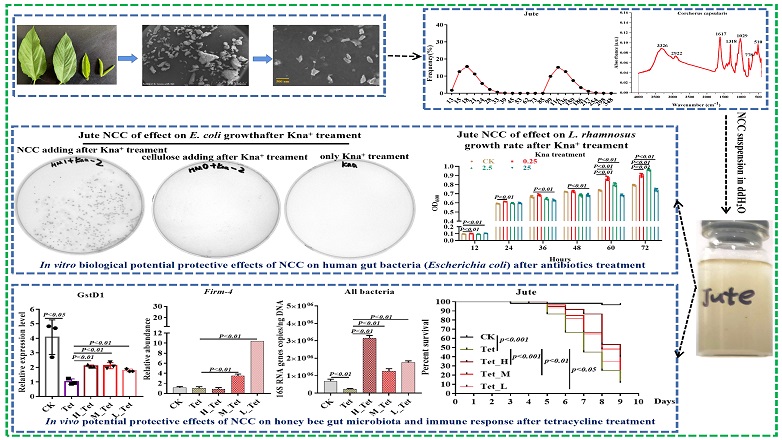
Researchers of the innovative team of utilization and biosynthesis of bioactive compounds from the Institute of Bast Fiber Crops, Chinese Academy of Agricultural Sciences, systematically studied the protective effect of nanocrystalline cellulose extracted from jute (Corchorus olitorius L.) leaves on probiotics and revealed that low-dose NCC performed a satisfactorily as a specific probiotic to mitigate the adverse effects of antibiotics on gut bacteria.
Antibiotics are used to fight pathogens, but they also attack commensal bacteria, disrupting the composition of intestinal microbiota, and causing dysbiosis and disease. The collateral damage to intestinal microbiota caused by antibiotics has recently received increasing attention. Some studies have highlighted the interaction between antibiotic-induced long-term microbiota changes and various allergic, metabolic, immunological, and inflammatory dysfunctions. The gut microbial diversity is reduced after ingesting antibiotics, and full restoration of the original bacterial community is rarely achieved. Thus, founding more effective probiotics or food additives with few side effects to treat antibiotic damage is becoming urgent.
The research team developed a method for preparation of jute nanocrystalline cellulose(JNCC). Subsequently, researchers evaluated the protective effect of JNCC and jute cellulose on human model gut bacteria (Lacticaseibacillus rhamnosus and Escherichia coli) under antibiotic stress by measuring bacteria growth and colony forming units, and found that JNCC is more effective than cellulose at adsorbing antibiotics and defending the gut bacteria E. coli. Meanwhile, interestingly, researchers also found that the low-dose JNCC clearly maintained the balance of key gut bacterial like Snodgrassella alvi and Lactobacillus Firm-4 in the bees treated with tetracycline, and reduced the toxicity caused by antibiotics. The present study has revealed the better protective effects of JNCC than cellulose on gut microbiota against some common antibiotics including kanamycin and tetracycline. One reason for the protective effect of JNCC on the gut microbiota can be attributed to the adsorption of antibiotics and the formation of a viscous layer surrounding the bacteria by the polysaccharides. On the other hand, JNCC can be used as a prebiotic to replace dietary fiber for the therapy of antibiotic-related dysbiosis with good biosafety for the host. This study firstly showed that low-dosage JNCC performed better as a specific prebiotic or as an alternative for medications to mitigate the adverse effects of antibiotics on intestinal bacteria and gastrointestinal diseases, which expands the applications of nanosized plant fibers in the field of food and medical treatments.
This work was supported by National Natural Science Foundation of Hunan province (2022JJ30651), the Central Public-Interest Scientific Institution Basal Research Fund (Y2021YJ25), and the Science and Technology Innovation Project of Chinese Academy of Agricultural Sciences (CAAS-ASTIP-2022-IBFC).
The study entitled Dual roles of nanocrystalline cellulose extracted from jute (Corchorus olitorius L.) leaves in resisting antibiotics and protecting probiotics has been published online in Nanoscale Advances journal and can be accessed through the following link https://pubs.rsc.org/en/content/articlelanding/2023/na/d3na00345k.

Fig.The preparation of JNCC and its the protective effect on gut microbiota

